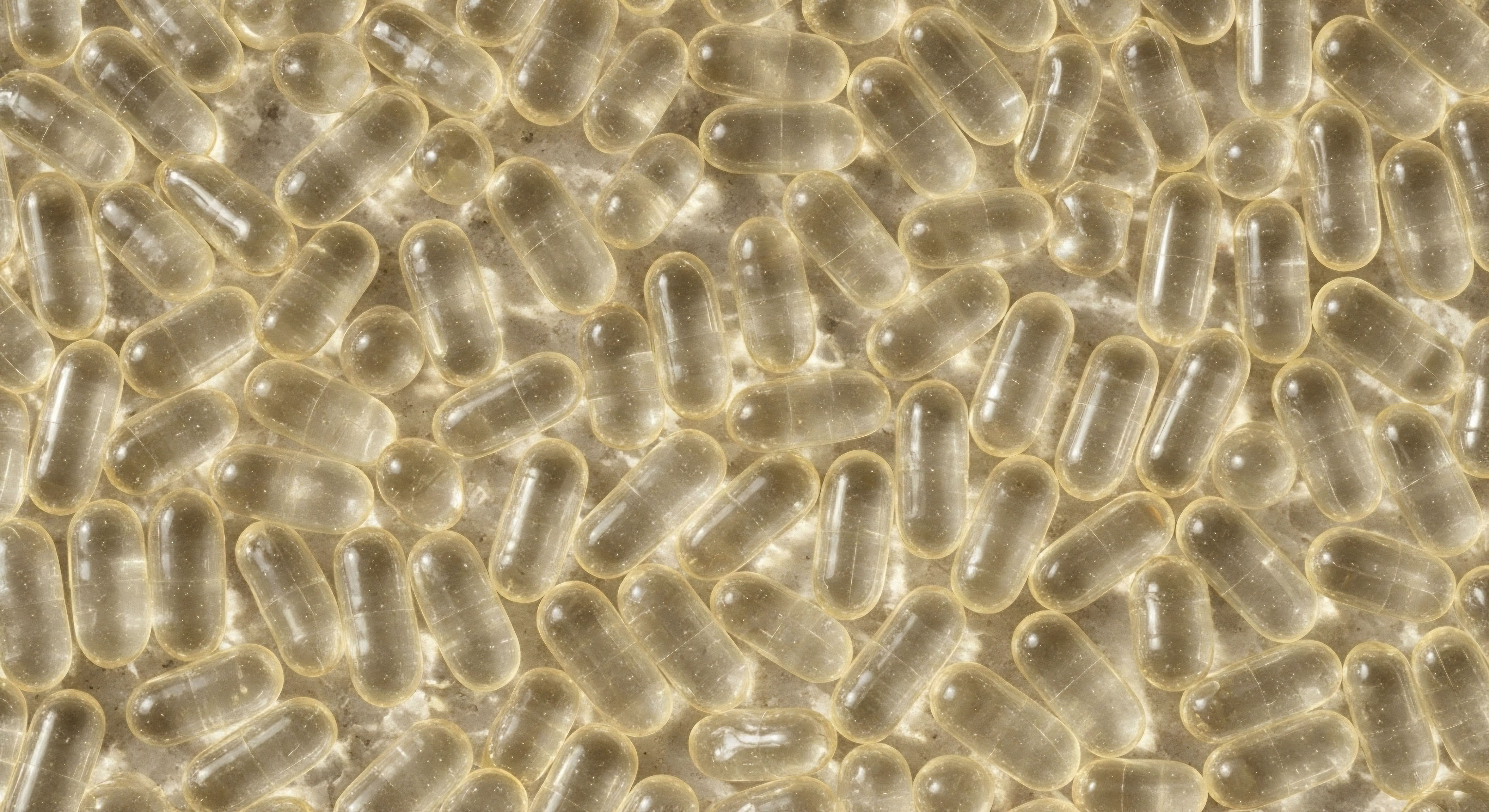

Fundamentals
Many individuals experience a subtle yet persistent shift in their overall well-being, a feeling that something within their biological framework is operating below its optimal capacity. This often manifests as a persistent fatigue that no amount of rest seems to alleviate, a recalcitrant weight gain despite diligent efforts, or a noticeable decline in mental sharpness and emotional equilibrium.
These sensations are not simply a consequence of aging; they frequently signal a deeper imbalance within the body’s intricate messaging network, the endocrine system. Understanding these internal communications is the initial step toward reclaiming vitality and function.
The endocrine system functions as a sophisticated internal communication network, employing chemical messengers known as hormones to orchestrate nearly every physiological process. These compounds are synthesized by specialized glands and travel through the bloodstream, delivering precise instructions to target cells and tissues throughout the body. Consider them as the body’s internal messaging service, ensuring that growth, metabolism, reproduction, mood, and sleep cycles are all meticulously coordinated. When these messages are clear and delivered effectively, the body operates with seamless efficiency.
The scientific understanding of these powerful biological agents is not static; it is a continuously evolving field. What was once considered a definitive classification or application for a hormonal compound can undergo significant revision as new research emerges, diagnostic capabilities advance, and clinical experience accumulates. This dynamic nature extends to how regulatory bodies oversee and categorize these substances, reflecting a commitment to public health and safety that adapts to the latest evidence.
The endocrine system, a complex internal messaging network, uses hormones to coordinate vital bodily functions, and our scientific understanding of these compounds is constantly evolving.

How Do Hormonal Signals Orchestrate Bodily Functions?
Hormones exert their influence through highly specific interactions with receptors on or within target cells. This interaction initiates a cascade of biochemical events, leading to a particular physiological response. For instance, insulin, a pancreatic hormone, binds to receptors on muscle and fat cells, signaling them to absorb glucose from the bloodstream, thereby regulating blood sugar levels. Conversely, thyroid hormones regulate metabolic rate across almost all body cells, influencing energy production and utilization.
The regulation of hormone production and release is governed by intricate feedback loops. A classic example is the hypothalamic-pituitary-gonadal (HPG) axis. The hypothalamus releases gonadotropin-releasing hormone (GnRH), which prompts the pituitary gland to secrete luteinizing hormone (LH) and follicle-stimulating hormone (FSH).
These pituitary hormones then stimulate the gonads (testes in men, ovaries in women) to produce sex hormones like testosterone, estrogen, and progesterone. As levels of these sex hormones rise, they signal back to the hypothalamus and pituitary, inhibiting further release of GnRH, LH, and FSH. This self-regulating mechanism maintains hormonal balance within a narrow physiological range.
Disruptions to these delicate feedback mechanisms, whether due to aging, environmental factors, or underlying health conditions, can lead to a cascade of symptoms. A decline in testosterone levels in men, often termed andropause, can manifest as reduced energy, diminished muscle mass, and changes in mood.
Similarly, the hormonal shifts during perimenopause and post-menopause in women can lead to irregular cycles, hot flashes, and alterations in cognitive function. Recognizing these systemic connections is paramount to addressing the root cause of symptoms rather than simply managing their manifestations.


Intermediate
Moving beyond the foundational understanding of hormonal communication, we consider the clinical strategies employed to restore and optimize endocrine function. These personalized wellness protocols are designed to recalibrate the body’s internal systems, addressing specific deficiencies or imbalances identified through comprehensive diagnostic evaluations. The application of these therapies, whether through hormonal optimization protocols or targeted peptide interventions, requires a precise understanding of their mechanisms and the regulatory frameworks governing their use.
Testosterone Replacement Therapy (TRT) represents a cornerstone of hormonal optimization for both men and women experiencing symptomatic deficiencies. For men, this often addresses symptoms associated with low testosterone, such as reduced vitality, decreased libido, and changes in body composition. A standard protocol might involve weekly intramuscular injections of Testosterone Cypionate, typically at a concentration of 200mg/ml.
To maintain natural testosterone production and preserve fertility, particularly in younger men, Gonadorelin is often administered via subcutaneous injections twice weekly. This compound stimulates the pituitary gland to release LH and FSH, thereby supporting testicular function.
To mitigate potential side effects such as the conversion of testosterone to estrogen, an aromatase inhibitor like Anastrozole may be prescribed as an oral tablet, usually twice weekly. In some cases, medications such as Enclomiphene are included to specifically support LH and FSH levels, offering an alternative or adjunct to other therapies.
For women, hormonal balance protocols address symptoms that span irregular cycles, mood fluctuations, hot flashes, and diminished sexual desire. Testosterone Cypionate is also utilized, though at significantly lower doses, typically 10 ∞ 20 units (0.1 ∞ 0.2ml) weekly via subcutaneous injection. The inclusion of Progesterone is determined by menopausal status, playing a vital role in uterine health and overall hormonal equilibrium.
Some women may opt for pellet therapy, which involves the subcutaneous insertion of long-acting testosterone pellets, providing a sustained release of the hormone. Anastrozole may be considered when appropriate, particularly if estrogen conversion becomes a concern.
Personalized hormonal optimization protocols, including TRT for men and women, utilize specific compounds like Testosterone Cypionate and Gonadorelin, often with adjunct medications to manage side effects and support overall endocrine function.

Comparing Testosterone Optimization Protocols
| Aspect | Testosterone Replacement Therapy Men | Testosterone Optimization Women |
|---|---|---|
| Primary Target Audience | Middle-aged to older men with low testosterone symptoms | Pre-menopausal, peri-menopausal, and post-menopausal women with relevant symptoms |
| Typical Testosterone Compound | Testosterone Cypionate (200mg/ml) | Testosterone Cypionate (0.1 ∞ 0.2ml) |
| Administration Frequency | Weekly intramuscular injections | Weekly subcutaneous injections |
| Adjunct Medications (Men) | Gonadorelin (2x/week subcutaneous), Anastrozole (2x/week oral), Enclomiphene (optional) | Progesterone (based on menopausal status), Anastrozole (when appropriate) |
| Alternative Delivery | Topical gels, patches (less common in specified protocol) | Pellet therapy (long-acting testosterone pellets) |
Beyond traditional hormonal optimization, Growth Hormone Peptide Therapy offers a distinct avenue for active adults and athletes seeking benefits such as anti-aging effects, muscle gain, fat loss, and improved sleep quality. Key peptides in this category include Sermorelin, a growth hormone-releasing hormone (GHRH) analog that stimulates the pituitary’s natural production of growth hormone.
Others like Ipamorelin / CJC-1295 (without DAC) work synergistically to enhance growth hormone pulsatility. Tesamorelin is another GHRH analog with specific applications, while Hexarelin and MK-677 (Ibutamoren) also influence growth hormone secretion through different mechanisms. These compounds are typically administered via subcutaneous injections.
Other targeted peptides address specific physiological needs. PT-141 (Bremelanotide) is utilized for sexual health, acting on melanocortin receptors in the brain to improve libido and sexual function. Pentadeca Arginate (PDA) is gaining recognition for its role in tissue repair, accelerating healing processes, and mitigating inflammation. These peptides represent a sophisticated approach to modulating biological pathways for specific therapeutic outcomes.

What Factors Drive Regulatory Reclassification of Hormonal Agents?
The classification of hormonal compounds by regulatory bodies, such as the U.S. Food and Drug Administration (FDA) or the European Medicines Agency (EMA), is a rigorous process. Initial classification typically occurs during the new drug application (NDA) process, where a compound is designated as a prescription drug, over-the-counter (OTC), or a controlled substance, based on its safety profile, efficacy, and potential for abuse. This initial designation is not immutable.
Regulatory reclassification can occur for several reasons, driven by the continuous accumulation of scientific evidence and evolving public health considerations.
- New Clinical Data ∞ Post-market surveillance and additional clinical trials can reveal new safety concerns, previously unrecognized side effects, or a broader understanding of a compound’s risk-benefit profile. Conversely, new data might demonstrate a wider therapeutic window or a lower risk profile than initially perceived, potentially supporting a less restrictive classification.
- Changes in Understanding of Mechanism ∞ As scientific knowledge advances, a deeper understanding of how a hormone or peptide interacts with biological systems can influence its classification. For instance, if a compound initially thought to have a narrow therapeutic index is later found to have a wider one, its regulatory status might be reconsidered.
- Public Health Needs ∞ Shifting public health priorities or the emergence of new health challenges can prompt regulators to re-evaluate access to certain compounds. An example might be the reclassification of certain medications from prescription-only to OTC status to improve public access for common conditions, provided safety can be assured without direct medical supervision.
- Abuse Potential ∞ Compounds with a potential for misuse or diversion, particularly those affecting the central nervous system or athletic performance, are subject to stringent control. If new evidence suggests a higher or lower abuse potential than initially assessed, a compound’s scheduling as a controlled substance can be adjusted.
- New Delivery Methods ∞ The development of novel delivery systems (e.g. long-acting injectables, transdermal patches) can alter a compound’s pharmacokinetic profile, potentially affecting its safety and efficacy, and thus its regulatory classification.
The process of reclassification is often lengthy and involves extensive review of scientific literature, expert panel consultations, and public comment periods. It reflects a commitment to ensuring that the regulatory status of a compound aligns with the most current and comprehensive understanding of its properties and societal impact.


Academic
The discourse surrounding the reclassification of hormonal compounds by regulatory bodies necessitates a deep exploration into the underlying endocrinology, the intricacies of systems biology, and the rigorous processes of clinical evidence generation. This is not a simple administrative adjustment; it represents a dynamic interplay between scientific discovery, clinical application, and public health policy.
To truly grasp the potential for reclassification, one must appreciate the complex feedback loops that govern hormonal physiology and the evolving methodologies for assessing therapeutic efficacy and safety.
Consider the hypothalamic-pituitary-gonadal (HPG) axis, a prime example of a neuroendocrine feedback system. The hypothalamus, a region of the brain, secretes gonadotropin-releasing hormone (GnRH) in a pulsatile manner. This pulsatility is critical; continuous GnRH stimulation can lead to desensitization of pituitary receptors.
GnRH then acts on the anterior pituitary gland, stimulating the release of luteinizing hormone (LH) and follicle-stimulating hormone (FSH). In men, LH stimulates Leydig cells in the testes to produce testosterone, while FSH supports spermatogenesis in Sertoli cells. In women, LH and FSH regulate ovarian follicle development, ovulation, and the production of estrogen and progesterone.
The circulating levels of these gonadal hormones then exert negative feedback on the hypothalamus and pituitary, modulating GnRH, LH, and FSH secretion. Disruptions to this axis, whether from aging, chronic illness, or exogenous hormone administration, can have far-reaching systemic consequences.
The therapeutic application of compounds like Testosterone Cypionate directly influences this axis. Exogenous testosterone administration can suppress endogenous LH and FSH production, leading to testicular atrophy and impaired spermatogenesis. This is why protocols often include agents like Gonadorelin, a GnRH analog, or selective estrogen receptor modulators (SERMs) such as Clomid (clomiphene citrate) or Tamoxifen.
Gonadorelin, when administered pulsatilely, can stimulate endogenous LH and FSH release, helping to preserve testicular function and fertility. Clomid and Tamoxifen, by blocking estrogen receptors in the hypothalamus and pituitary, disrupt the negative feedback loop, thereby increasing GnRH, LH, and FSH secretion, which in turn stimulates endogenous testosterone production. The nuanced understanding of these interactions is paramount for optimizing patient outcomes and minimizing adverse effects.
The reclassification of hormonal compounds is a complex process influenced by evolving scientific understanding of neuroendocrine axes, rigorous clinical evidence, and public health considerations.

Does Evolving Clinical Evidence Always Prompt Regulatory Adjustments?
The process of regulatory reclassification is inherently evidence-driven, yet it is not always immediate or straightforward. It relies heavily on robust data from Phase IV clinical trials, which are conducted after a drug has been approved and marketed. These trials gather additional information about a drug’s safety, efficacy, and optimal use in diverse populations.
Furthermore, pharmacovigilance systems, which involve the continuous monitoring of drug safety in the real world through adverse event reporting, play a critical role. Spontaneous reports from healthcare professionals and patients, coupled with analyses of large administrative databases, can identify rare or delayed adverse reactions that were not apparent during pre-market trials.
Scientific advisory committees, composed of independent experts in endocrinology, pharmacology, toxicology, and public health, review this accumulating evidence. Their consensus recommendations inform regulatory decisions. The reclassification of a compound from prescription-only to over-the-counter (OTC) status, for example, requires compelling evidence that the drug can be safely and effectively used by consumers without the direct supervision of a healthcare provider.
This involves assessing the drug’s therapeutic index, the clarity of its labeling, and the ability of consumers to self-diagnose and manage the condition.
Consider the case of growth hormone and its analogs. Peptides like Sermorelin and Ipamorelin / CJC-1295 (without DAC) function as growth hormone-releasing hormone (GHRH) agonists. They stimulate the somatotroph cells in the anterior pituitary to secrete endogenous growth hormone.
This differs from direct administration of recombinant human growth hormone (rhGH), which is a tightly regulated prescription drug primarily indicated for specific growth hormone deficiencies. The regulatory landscape for GHRH agonists and other peptides, such as Tesamorelin (another GHRH analog approved for HIV-associated lipodystrophy) or Hexarelin (a growth hormone secretagogue), is constantly evaluated as more research emerges regarding their long-term safety and efficacy for broader applications, such as anti-aging or performance enhancement.
The distinction between a drug and a “supplement” or “research chemical” can be fluid, and new evidence can prompt a re-evaluation of these categories.

Regulatory Reclassification Pathways
| Pathway Type | Description | Driving Factors | Impact on Access |
|---|---|---|---|
| Prescription to OTC Switch | Reclassifying a drug from requiring a prescription to being available over-the-counter. | Demonstrated safety and efficacy for self-use, low potential for misuse, clear labeling for consumer understanding. | Increased public access, lower cost, greater convenience. |
| Controlled Substance Scheduling Change | Adjusting the schedule (e.g. Schedule III to Schedule II) of a drug based on its abuse potential and medical utility. | New evidence of higher or lower abuse risk, changes in medical consensus on therapeutic value. | More stringent (higher schedule) or less stringent (lower schedule) prescribing and dispensing requirements. |
| New Indication Approval | Approving a drug for a new medical use beyond its initial approval. | Results from new clinical trials demonstrating efficacy and safety for the additional indication. | Expanded therapeutic options for patients and clinicians. |
| Withdrawal from Market | Removing a drug from the market due to significant safety concerns or lack of efficacy. | Discovery of severe, unacceptable adverse events or failure to demonstrate continued benefit in post-market studies. | Complete cessation of availability for patient use. |
The complexity extends to compounds like PT-141 (Bremelanotide), a synthetic melanocortin receptor agonist. Its mechanism involves activation of melanocortin receptors in the central nervous system, influencing sexual desire. While approved for hypoactive sexual desire disorder in women, its broader application and potential for off-label use are subjects of ongoing scientific and regulatory scrutiny.
Similarly, Pentadeca Arginate (PDA), a peptide with tissue repair and anti-inflammatory properties, represents a class of compounds where the evidence base is continuously expanding, potentially leading to new classifications or approved indications as robust clinical data accumulates.
The regulatory landscape is not merely reactive; it is also proactive in anticipating potential public health implications. The interplay between scientific discovery, clinical practice, and regulatory oversight is a continuous feedback loop, aiming to ensure that therapeutic compounds are utilized safely and effectively, aligning with the most current understanding of human physiology and pathology. The reclassification of hormonal compounds is a testament to this dynamic process, reflecting a commitment to adapting policy to the evolving frontiers of medical science.
- Scientific Advancements Influencing Reclassification ∞
- Genomic and Proteomic Insights ∞ Deeper understanding of individual genetic variations influencing hormone metabolism and receptor sensitivity.
- Advanced Imaging Techniques ∞ Improved ability to visualize endocrine glands and detect subtle pathological changes.
- Biomarker Discovery ∞ Identification of novel biomarkers that predict response to therapy or risk of adverse events.
- Real-World Evidence ∞ Accumulation of data from electronic health records and patient registries providing insights into long-term outcomes.
- Pharmacogenomics ∞ The study of how genes affect a person’s response to drugs, allowing for more personalized and potentially safer dosing.
- Challenges in Regulatory Oversight of Hormonal Compounds ∞
- Off-Label Use ∞ The widespread practice of prescribing drugs for unapproved indications, which can complicate safety monitoring.
- Compounded Preparations ∞ The use of custom-made hormonal formulations, which may not undergo the same rigorous regulatory scrutiny as commercially manufactured drugs.
- Global Harmonization ∞ Differences in regulatory standards and processes across various countries, leading to inconsistencies in drug availability and classification.
- Rapid Scientific Progress ∞ The pace of new discoveries in endocrinology can outstrip the speed of regulatory review and adaptation.
- Public Perception and Misinformation ∞ The influence of anecdotal evidence and unsubstantiated claims on public demand for certain hormonal therapies.

References
- Boron, Walter F. and Emile L. Boulpaep. Medical Physiology. 3rd ed. Elsevier, 2017.
- Guyton, Arthur C. and John E. Hall. Textbook of Medical Physiology. 14th ed. Elsevier, 2020.
- Melmed, Shlomo, et al. Williams Textbook of Endocrinology. 14th ed. Elsevier, 2020.
- Nieschlag, Eberhard, et al. Testosterone ∞ Action, Deficiency, Substitution. 6th ed. Cambridge University Press, 2020.
- Miller, Karen K. et al. “Effects of Growth Hormone and Testosterone on Body Composition and Muscle Function in Older Men.” Journal of Clinical Endocrinology & Metabolism, vol. 99, no. 1, 2014, pp. 162-170.
- Basaria, Shehzad, et al. “Adverse Events Associated with Testosterone Administration.” New England Journal of Medicine, vol. 374, no. 15, 2016, pp. 1446-1454.
- Davis, Susan R. et al. “Testosterone for Women ∞ The Clinical Practice Guideline of The Endocrine Society.” Journal of Clinical Endocrinology & Metabolism, vol. 101, no. 10, 2016, pp. 3653-3668.
- Snyder, Peter J. et al. “Effects of Testosterone Treatment in Older Men.” New England Journal of Medicine, vol. 374, no. 7, 2016, pp. 611-621.
- Yuen, Kevin C. J. et al. “Consensus Statement on the Management of Adult Growth Hormone Deficiency.” Journal of Clinical Endocrinology & Metabolism, vol. 99, no. 11, 2014, pp. 3902-3935.
- Shifren, Jan L. et al. “Bremelanotide for Hypoactive Sexual Desire Disorder in Women ∞ A Randomized, Placebo-Controlled Trial.” Obstetrics & Gynecology, vol. 136, no. 1, 2020, pp. 117-126.

Reflection
Understanding the intricate world of hormonal health is not merely an academic exercise; it is a deeply personal journey toward self-discovery and reclaiming one’s innate vitality. The knowledge shared here, from the fundamental orchestration of biological signals to the sophisticated application of personalized protocols and the dynamic nature of regulatory oversight, serves as a foundation. It is a starting point for introspection, prompting you to consider how these complex systems operate within your own unique biological framework.
The path to optimal well-being is rarely a one-size-fits-all solution. It demands a partnership with knowledgeable clinicians who can translate complex laboratory data and scientific principles into actionable strategies tailored precisely to your individual needs and aspirations.
This information empowers you to engage in more informed conversations about your health, asking precise questions and advocating for a truly personalized approach. Your body possesses an inherent intelligence, and by understanding its language, you hold the key to unlocking its full potential.



